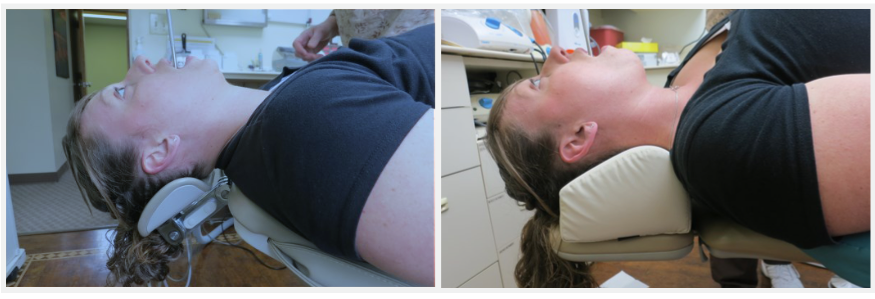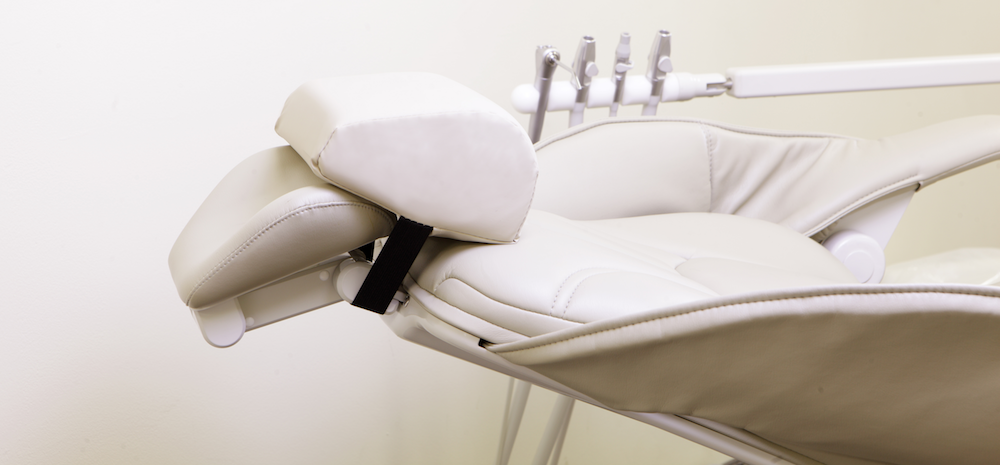Why Use Dental Chair Memory Foam Headrests?
Memory foam headrests provide two major benefits to dental providers and their patients:
- Comfort
- Ergonomic positioning
The comfort provided by memory foam dental headrests extends to both patients and providers. While memory foam provides a soft and comfortable surface that keeps patients relaxed, this also means that they will remain steady during treatment, allowing dental professionals to work more comfortably.
Memory foam headrests also position patients in the most optimal position possible, regardless of the type of chair being used. This means that dentists and hygienists are able to ergonomically position themselves during treatment, reducing strain on their bodies, preventing musculoskeletal issues and extending the length of their careers.
How Does Memory Foam Work?
The open cell memory foam found at the center of every dental headrest made by Crescent Products gently gives when a force is applied to it and returns to its original shape when that force is removed. This allows patients to feel comfortable whether they are seated or lying in the dental chair. When they get up, the headrest returns to its normal shape without incurring any damage.
How does memory foam work, exactly? Memory foam is made of polyurethane and other chemicals that give it three distinct properties:
- Viscosity
- Elasticity
- Density
Viscosity is a material’s resistance to deformation due to stress. It refers to something that is fluid (like tree sap). The viscosity of memory foam combines with its elasticity, the ability of something to return to its normal shape after deformation, to create what is known as viscoelasticity. Viscoelastic materials have both the ability to resist deformation by a force and the ability to return to its natural shape when the force is no longer applied to it. In practical terms, this means you can rest assured that a Crescent Headrest will retain its shape after your first patient, and your thousandth patient.
Density, an object’s mass per unit of volume, determines how concentrated (or compact) a material is. The foam density of Crescent’s Memory foam headrests have the perfect level of comfort. The material is dense enough so that it doesn’t collapse too much when a patient rests their head on it but is soft enough to make the surface comfortable. This creates a comfortable, yet stable surface.
In simpler terms, standard polyurethane foam has far more resiliency and elasticity, which creates resistance when compressed. Over a short period of time that resistance can cut off circulation and lead to discomfort. The viscosity of a memory foam products allows the foam to conform and support the body without resistance, making them more comfortable to lie on for long periods of time. Memory foam will also slowly recover to its original shape when the pressure is removed.
How Memory Foam Headrests Benefit Patients
- Reduces dental anxiety and stress
- Keeps them warmer and more comfortable during treatment
- Reduces fidgeting during treatment
- Alleviates pressure and pain in the back, hips, knees and neck
How Memory Foam Headrests Benefit Providers
- Properly positions patients for optimal treatment
- Providers can maintain an ergonomic position while treating
- Reduce pain and chance of musculoskeletal disorders
- Increases career longevity and happiness
- Earn return business by creating a memorable dental experience
Memory Foam Helps Prevent Musculoskeletal Disorders
Dentists and hygienists must keep their health and well-being in mind. A large majority of dentists and hygienists face musculoskeletal issues throughout their career. In the worst-case scenarios, these issues force dental providers into early retirement.
Proper patient positioning with a memory foam headrest helps dental operators achieve better ergonomic positioning for themselves. When a patient is positioned correctly, dentists and hygienists can maintain a more healthy and stable positioning: headrests reduce stress on the lower, mid and upper back as well as the joints in the wrists, elbows, and shoulders. They even relieve tension and stress on the spinal segments of the neck.
To preserve the best ergonomic working posture when working behind the upper arch, patients should be positioned so that the occlusal plane of the upper arch is 20-25 degrees behind the vertical.

By simply placing their patients in this position, dental providers don’t have to awkwardly position themselves during treatment. This relieves the strain on their muscles and joints, reducing pain, joint misalignment and other career-impeding issues.
A Memory Foam Headrest for Any Occasion
When it comes to patient comfort and positioning, there is no one-size-fits-all solution. Patients come in all shapes and sizes: from small children to fully grown adults and everyone in between. That’s why we at Crescent Products created a range of dental headrests, each of which have garnered praise from dentists across the country.
When looking for a memory foam headrest, you can choose from one of three options:
The Original Headrest: ideal for adult patients in chairs with a flat headrest.
The Low-Profile Headrest: co-developed with a leading dental ergonomic expert. This product works with a double-articulating headrest and allows for the maximum visibility and ergonomic positioning.
The Geriatric Headrest: perfect for elderly patients who cannot easily recline their head in a chair.
Learn More About Headrest Options »
Care and Comfort for All
No matter which memory foam headrest you need for your patient care, make a it a headrest from a company that is recommended by dentists nationwide. Everything from our headrests to our chair pads, backrests and knee supports can help improve your patient care, prevent dental anxiety and reduce musculoskeletal pain in dentists and hygienists.
